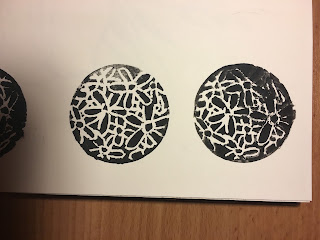Over reading week I took a step
back and looked at my work I
wasn’t entirely happy. When I was looking at
wallpaper samples I had a clear favourite which was almost opposite to my
current designs. Although the pattern was originally hand drawn, when it was
printed it seemed too mass-produced. It took away the organic pattern and style
of the original drawing. I took advice from my tutor and considered why it had
to be a single image repeated in such a clinical way. My reasoning for this was
that for me, it looked clean and proffesinal when it was presented this way. I
decided to just draw and the resonse I got to just a doodle on the wall was so
positive I decided to go in another direction with my prints.
I didn’t agree with my peers as for
me the drawing was too messy and untidy in design but when I planned out my
design instead of automatic draweing the design was much cleaner, more thought
out and cleaner. Because of the detail in the print, to get the important
repeat in there I had to trace the pattern and then line it 3 times because I
discovered hand-drawing my pattern and having that craft element to the print
is very important. You can tell when you see the print that it has taken time
and care to create.
The print is different to my
original idea because it is a compliation of my research and trial and error.
The flowers in this print are all taken from observational drawings that I have
so far produced. I like this as it makes the print very personal in that I have
captured these flowers and am still drawing from them. The pattern winds and
weaves around the paper guiding the eye to different elements and flowers
within the piece. Colour adds to this experience as I have added little touched
of colour throughout the pattern. Colour was important as it adds to the
decorativeness of the piece and makes it aesthetically pleasing, without colour
the strip of pattern looks like a colouring book with bold black lines.
The end piece was just over six
foot in length and I decided to display it on the wall like it would be if it
were being pasted on the wall for wallpaper. I stuck it flat to the wall and
from the top of the skirting board. This made the piece look decorative as a
piece of wallpaper.
I would ideally like to create a
longer piece so that it could cover the length of the wall and I would also
like to make the repeated pattern more prominent so that the viewer would be
able to see the reason behind the pattern.










































